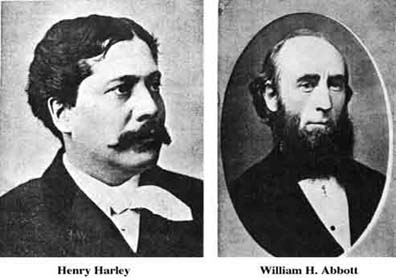 |
||||||
1865, The Big Year
One other mention of Van Syckel and his pipeline is deserved here. Although Van Syckel may not have realized all of the ramifications of his two 1865 pipelines, they marked the beginning of the end of the wooden oil barrel. These barrels gradually disappeared from sight in the oil region, pushed out of use by the pipelines, railway tank car (1865) and bulk boats. The 42 gallon barrel became a unit of measurement, although many of us still see it as a hoop-bound container in our mind's eye. The amount of oil conveyed in pipelines and transported in tankers is still expressed in terms of barrels, but the actual barrel is no longer present. Van Syckel in 1864 wanted to manufacture barrels, but that would have still left him bound to the teamsters' wagons. Fortunately, his attention turned to the pipeline which he improved so that it could successfully carry oil over the hills under pump pressure.
By late 1865 a six-inch gravity pipeline (no pumps) was completed by the Pennsylvania Tubing and Transportation Company along Pithole Creek from the Pithole oilfield to the mouth of the creek where it flows into the Allegheny River. This line delivered 7000 barrels of oil to its terminus per day and was expedited by a gradient of 52 feet per mile (Giddens, 1938). A town by the name of Oleopolis (still on the map) sprung up at the mouth of Pithole Creek on the property of the Baltimore Petroleum Company and a 15,000 barrel iron storage tank was erected there (Derrick Handbook, 1898).
The Pithole oil boom spawned several pipelines besides Van Syckel's and Oleopolis. One of these was a two-inch line from Pithole to Henry's Bend on the Allegheny River. It commenced to deliver oil on October 24, 1865. The pipeline was four miles long and had a through-put of 2000 barrels per day (Giddens, 1938).
A two-inch double pipeline was started in late 1865 by Henry Harley of Shaffer on Oil Creek. Harley's route climbed the big hill separating Benninghoff Run (tributary to Oil Creek) and the Oil Creek Railroad yard at Shaffer. The pipe was heavy weight and had one pump at Benninghoff Run which eventually allowed it to deliver 800 to 1000 barrels (some sources say 2000 barrels) of crude daily to Shaffer. Actually two lines were put into use, doubling the delivery. It wasn't completed until 1866 due to harassment and destructive attacks by teamsters who were plentiful in numbers through the area where the line was being laid. They looked at the pipelines as an infringement on their rights as common carriers (Oil & Gas Journal - Oil City Derrick, 1934).
Titusville was slow to react to the pipeline concept, but the rail shippers soon noticed that the quantity of oil to which they were accustomed had lessened on their platforms and apparently was being bled off at other points where competing railroads and pipelines met. In November, 1865, work on two two-inch lap welded wrought-iron pipelines (in the same ditch) to Pithole was commenced. It wasn't finished until the following year.
The events of the year 1865 turned out to be the spring board which launched a multitude of pipelines in the Pennsylvania oil region and neighboring oil-producing states. As soon as oilfields were found, pipelines would be planned. The development of railroad tank cars also took place in 1865 and underwent numerous modifications in a short time. Railroads were undergoing enormous expansion and, of course, the impetus for this growth was the oil industry and particularly the pipelines. The first pipelines were laid from the oilfields to railroad terminal stations. However, it wasn't long before the pipeliners began to eye the eastern seaboard so as to take over that leg of the journey then held by the railroads. This phenomenal expansion and competition in the transportation of crude oil and refined product by pipelines commenced via the seminal events that occurred in the early to mid 1860's as described here.
 |
William Hawkins Abbott like many versatile oilmen was variously involved in a number of major ventures in his oil career such as purchasing interests in wells and leases (including the Barnsdall well which was the first after Drake). He was a pioneer refiner at Titusville (1860), oil marketer and part owner of the Van Syckel pipeline (1866). He helped to found the Allegheny Transportation Company (1867), promoted the Union and Titusville Railroad, helped to build the Titusville-Pleasantville-Pithole plank road (1865), and was a builder and supporter of the St. James Memorial Church in Titusville. |
Henry Harley. Of the many great things that can be said about Henry Harley, probably the greatest was his determination and robust nature which carried him through the ordeal of laying a pipeline from Benninghoff Run to Shaffer on Oil Creek. He did this in 1865-66 in the face of mob rule and perilous obstruction brought about by the teamsters who were bent on destroying his line pipe by pipe even when it was being laid. Harley persevered and ignored the death threats although he lost much in the fires set by the teamsters. Soon after laying that pipeline, he and Abbott combined their interests and went on to be pipeline kings.
William Abbott together with Henry Harley are best known for their pipeline activities. They took the oil to market or, at least, to other facilities which saw it go on the rest of the way. Historians of the early transportation of oil see Abbott and Harley as prime movers in the conveyance of oil by pipelines from the oilfields to the railroad terminals.
![]()
| © 2004, Samuel T. Pees all rights reserved |
|